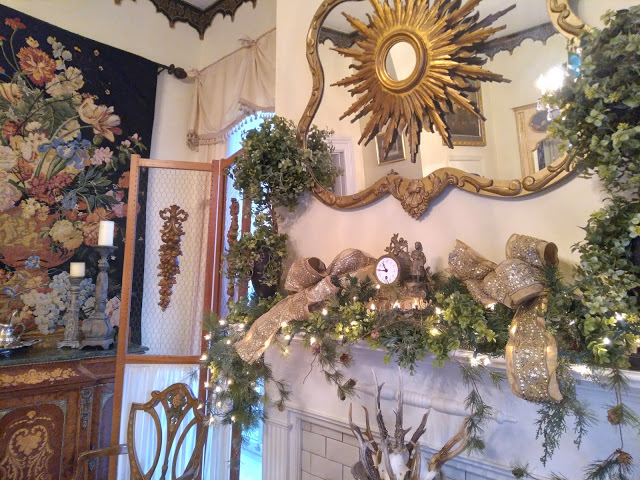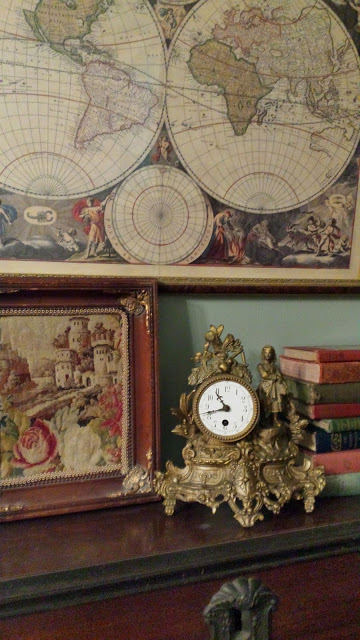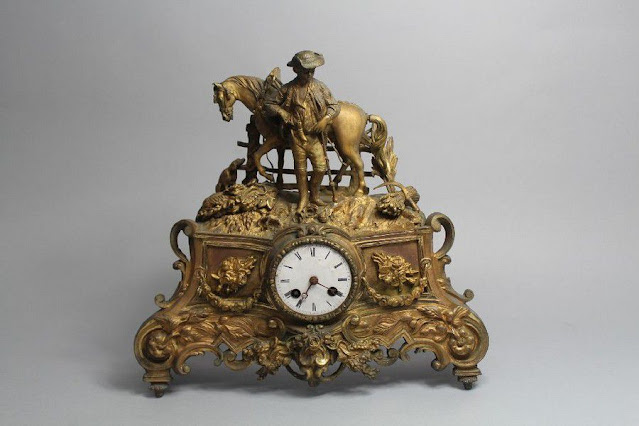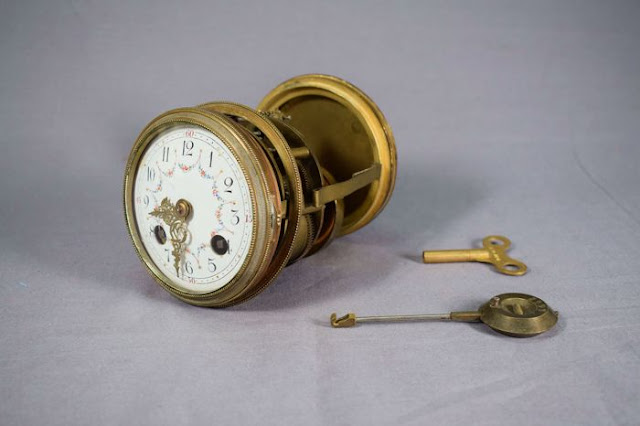This particular blog post features a passion of mine, the French figural mantel clock. I have collected a few over the years and enjoy them immensely. While there are many elaborate, dripping in gilt, expensive French clocks in antiques stores and collector's homes, they are not the focus of this post.
To me the charm of rural French chateau décor lies in it's romantic use of florals and rustic elegance. My favorite style French mantel clock is the bronze figural clock with charming pastoral-like scenes, inspired by the works of Fragonard and Watteau, known for their lush landscape paintings, that feature frolicking nobles in a more naturalistic and less formal setting.
These figural bronze mantel clocks feature statues of young maids or Lords and Ladies of the country chateau, shepherdesses, children, cherubs, shepherd boys tending their sheep, or young couples sharing a romantic interlude. They were even called "genre clocks" because they often portrayed everyday and whimsical scenes from life.
Mantel clocks (also known as shelf clocks) are so named because they were small enough to be displayed on a shelf or mantel. Unlike most elaborate French clocks of the day they were smaller and relatively inexpensive to make. They were affordable to own which explains why they were one of the most popular clocks of the 18th and 19th centuries.
Whether you are a collector or are just starting to appreciate the beauty of old world timeless décor, give some thought to these lovely mantel clocks. They offer an fun opportunity to obtain an authentic piece of historical art.
pinterest.com.uk
Initially invented with practicality and beauty in mind antique, French mantel clocks have been gracing fireplace mantels and shelves for more than two hundred and fifty years. Their delicate flowers and foliage designs, garlands, swags, scrollwork, and statuettes have given them high marks in the world of antiques.
There are good reasons these French mantle clocks have been around for over two centuries. They are elegant time tellers and eye candy pieces that have added distinction to homes since the 17th century. Moreover, they are pieces of the past that are much loved perennial favorites.
Thought the ticking and chimes of a French Mantel Clock might be a nice background for viewing the blog.
The 18th Century is sometimes called the ‘Age of Decoration', but this perhaps does a disservice to the complexity and accuracy of clocks made in this period
These French figural mantel clocks would need to be impressive. After all they were being used to adorn the mantels and other prominent locations in fine 18th century rooms.
Lisa Farmer-Eye For Design
For collectors and enthusiasts alike, owning an antique French figural clock is like owning a slice of history. I started my collection three years ago and have managed to find five at estate sales. This one is in my dining room and features a horse and rider.
By the end of the eighteenth century, the popularity of the mantel clock had spread quickly throughout Europe and was reaching the wealthier homes in the United States.
Lisa Farmer- Eye For Design
Far more than a practical necessity these French figural mantel clocks became valued for their appearance, intricate embellishments and detailing as much as for their function. This picture from Christmas shows another figural clock from my collection that sits on the mantel in my living room. It features a charming figure of a lady with her pet goat sitting on a rocky outcrop that houses the clock. There are painted inserts of frolicking courting couples.
There is a romance about these clocks that makes them so appealing.
via Pinterest
These wonderful figural clocks have adorned the fireplaces of fabulous French chateaux, royal castles and palaces, and wealthy manor homes.
The British designed their clock cases around clock movement which to them was considered the most important thing. However, the French gave importance to the CASE the movements would be housed in. Of course they would!
Antique French mantel clocks are pieces of art usually created in gilt bronze (in English) and ormolu or bronze doré (in French). Ormolu was used in decorations including moldings and embellishments especially in 17th and 18th century France.
Sometimes the original gilt is in remarkable condition or people have re-gilded them. Some choose to paint them a shiny gold if the bronze has lost it's gilding.
google.com
My personal preference, however, is for the bronze clocks to have patina and not be so shiny and gold. I tend to like the patina of age.
As well as being more accurate, these highly prized 18th Century clocks were more ornate as techniques for making and decorating clocks with ormolu and porcelain were discovered in Europe. The aristocracy loved them!
Lisa Farmer-Eye For Design
These clocks look great in all rooms of the house. This is another of my clocks and is surmounted with a lady and fruit related embellishments surrounded by foliage. I have used it on mantles.......
Lisa Farmer-Eye For Design
and I have used the same one in vignettes throughout the house. They are so versatile and fun to move around and enjoy in different ways.
Lisa Farmer- Eye For Design
Here is another from my collection that sits on the mantle of my bedroom. This one features a nobleman surrounded by foliage. On the top is a topiary in a Versailles style planter.
I have also used him on my desk. Like I said before, there are many ways to display these charming French clocks.
In today's home a figural mantel clock is not confined to the mantel. They are equally at home displayed on a beautiful antique chest. As you will see, there are many places you can use them to create magic!
Lisa Farmer-Eye For Design
This figural clock is in an area of my front hall and is of a young woman and her lamb sitting on a rock surrounded by greenery. She has been picking berries and is holding a basketful. The clock sits on a terracotta marble plinth. I love the way these French clocks always seem to elevate the spaces where I place them.
Consoles and tables are perfect display locations.
Even a dining room sideboard will do.
via Pinterest
Notice the glass dome!!!
all images via google.com
As you saw in the image above many collectors are lucky enough to have the glass dome that usually accompanied these French clocks. They are stunning when displayed this way. Finding these domes is extremely hard and they are very expensive. I have had dealers tell me that even when they locate one in France many times these fragile domes simply do not survive the shipping.
google.com
While French mantel clocks were first made in the 1600s, most contained brass inner workings, making them too expensive for most residents. It was not until other methods were invented that mantel clocks started being found in most homes.
cedarhillfarmhouse.com
French figural mantel clocks are great additions to the French country look. Look how pretty this one looks next to this fabulous French settee. Great for a bedroom or maybe use one to bring an old-world allure to a makeup vanity.
via Pinterest
I love this charming clock!
Even though they could be considered fancy these clocks are not over the top. This gives them the ability to fit in with an all white French farmhouse style......
no matter how simple.
catawiki.com
Few French clock manufacturers used labels, so a label is an indication that the clock isn't French. Some exceptions to this rule include Japy Freres. There are so many JAPY clocks still around because he and his grandfather, Frédéric Japy (1749-1812) were pioneers in the industrialization of not only clocks, but of manufacturing in general.
In clockmaking, Japy's enamel dials became the standard for the great majority of clock manufacturers for 150 years both in France and abroad.
images via Pinterest
These clocks are key wound and run from thirty hours to eight days, depending on the specific clock.
This style of clock does not have a glass bezel or rear door.
The reason there is no glass is because the dials of these French figural clocks are porcelain and you want them to show.
google.com
French mantel clocks from the 17th-19th centuries were often created as garnitures. Garniture is a French term used to describe a collection of decorative objects intended to be displayed together. A garniture included the mantel clock and two similarly decorated side-objects. These were usually two matching candelabras, vases, or urns.
Lovely French ormolu and marble three piece figural clock garniture.
via Pinterest
Sometimes these clocks would have painted porcelain inserts. This one shows a lady fishing. It looks like the bronze fishing pole has been broken off the statue.....but she is still lovely.
Yes, that is a beauty in front of the mirror, but my eye goes to the lovely figural clock on the table.
via Pinterest
These clocks are expensive unless you luck out at estate sales and auctions. Another trick is to buy just the case through something like ebay or etsy. Many times you can find them under clock parts. Then you wait for the right size clock movement to come along in the same way. I did that with my horse and rider clock. It took about 6 months to find the works (usually not working) but they are out there. You can get into $$$$$ if you want it to work.
google.com
Or you could forego the whole internal works and just find an antique porcelain dial. While you are waiting you can still clean it up and enjoy it's beauty and charm!
Or just use them as is!
Happy hunting!!
Click here to see the previous post
This blog post was published by Lisa Farmer
In the event that I have not credited the correct source of an image, please contact me at lisafarmerdesigns46@yahoo.com and I would be glad to correct it.






























































